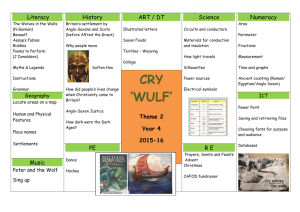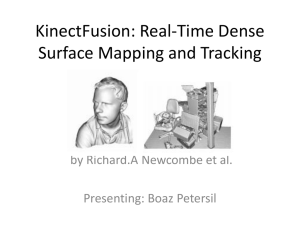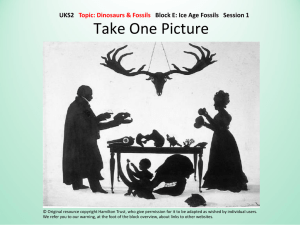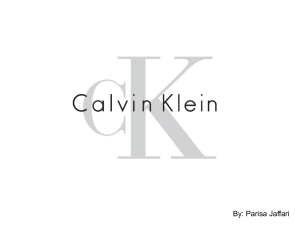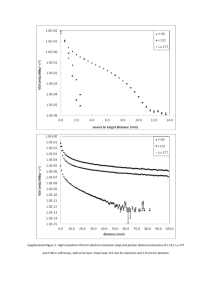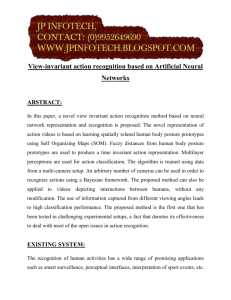Robust volumetric reconstruction from arbitrary multiple projections
advertisement
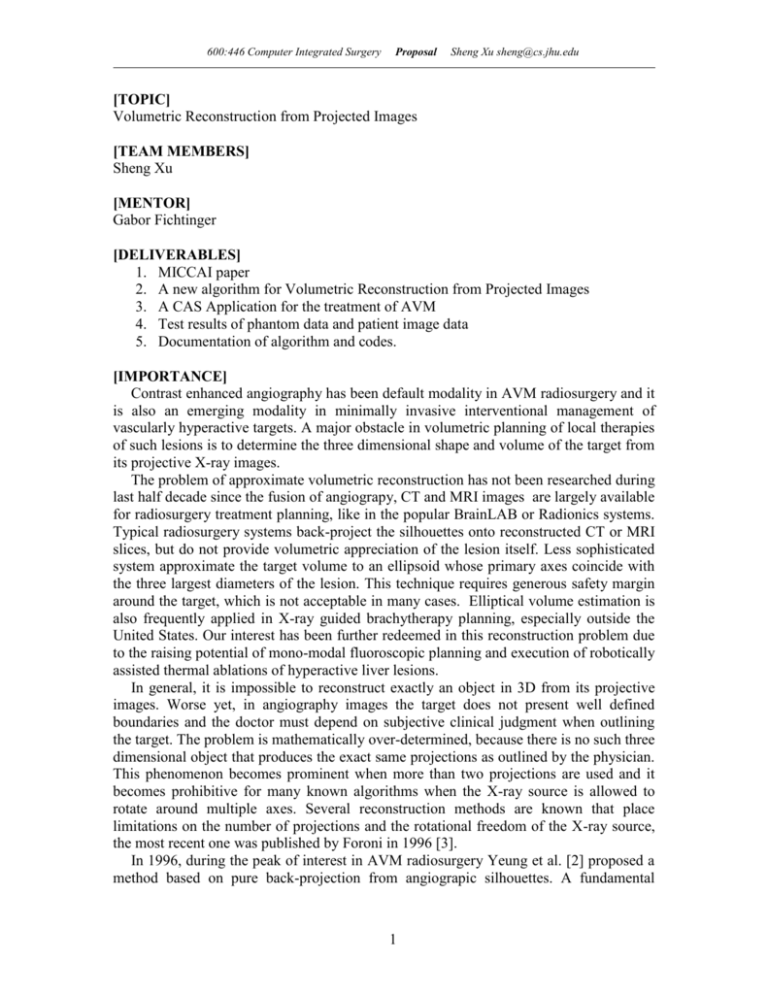
600:446 Computer Integrated Surgery Proposal Sheng Xu sheng@cs.jhu.edu [TOPIC] Volumetric Reconstruction from Projected Images [TEAM MEMBERS] Sheng Xu [MENTOR] Gabor Fichtinger [DELIVERABLES] 1. MICCAI paper 2. A new algorithm for Volumetric Reconstruction from Projected Images 3. A CAS Application for the treatment of AVM 4. Test results of phantom data and patient image data 5. Documentation of algorithm and codes. [IMPORTANCE] Contrast enhanced angiography has been default modality in AVM radiosurgery and it is also an emerging modality in minimally invasive interventional management of vascularly hyperactive targets. A major obstacle in volumetric planning of local therapies of such lesions is to determine the three dimensional shape and volume of the target from its projective X-ray images. The problem of approximate volumetric reconstruction has not been researched during last half decade since the fusion of angiograpy, CT and MRI images are largely available for radiosurgery treatment planning, like in the popular BrainLAB or Radionics systems. Typical radiosurgery systems back-project the silhouettes onto reconstructed CT or MRI slices, but do not provide volumetric appreciation of the lesion itself. Less sophisticated system approximate the target volume to an ellipsoid whose primary axes coincide with the three largest diameters of the lesion. This technique requires generous safety margin around the target, which is not acceptable in many cases. Elliptical volume estimation is also frequently applied in X-ray guided brachytherapy planning, especially outside the United States. Our interest has been further redeemed in this reconstruction problem due to the raising potential of mono-modal fluoroscopic planning and execution of robotically assisted thermal ablations of hyperactive liver lesions. In general, it is impossible to reconstruct exactly an object in 3D from its projective images. Worse yet, in angiography images the target does not present well defined boundaries and the doctor must depend on subjective clinical judgment when outlining the target. The problem is mathematically over-determined, because there is no such three dimensional object that produces the exact same projections as outlined by the physician. This phenomenon becomes prominent when more than two projections are used and it becomes prohibitive for many known algorithms when the X-ray source is allowed to rotate around multiple axes. Several reconstruction methods are known that place limitations on the number of projections and the rotational freedom of the X-ray source, the most recent one was published by Foroni in 1996 [3]. In 1996, during the peak of interest in AVM radiosurgery Yeung et al. [2] proposed a method based on pure back-projection from angiograpic silhouettes. A fundamental 1 600:446 Computer Integrated Surgery Proposal Sheng Xu sheng@cs.jhu.edu problem disregarded by the authors is that back-projection alone produces only a cloud of disjoint voxels that has to be solidified after the fact, in order to receive a solid 3D object. Yeung also failed to address the issue that the shadows obtained by a forward projection of a reconstructed object will not match the previously drawn silhouettes, because the silhouettes are always drawn inconsistently. (Again, the reason is that soft tissue targets and especially AVMs do not have well defined boundaries.) Back-projection alone does not allow for quantitative assessment of the consistency of silhouettes. On the other hand, this feature is highly desirable when the silhouettes are subject to intra-operative clinical judgment. Parallel to medical applications, a family of shape recovery methods have emerged in the fields of pattern recognition and computer vision. These algorithms, besides being rather complex and difficult to implement, also assume near exact silhouettes of the objects, therefore, they are not suitable for our purpose. All problems considered, we critically need a volumetric and shape estimation method that (A) uses no prior information of the shape and volume to be reconstructed, (B) does not require exact silhouettes, (C) accepts arbitrary number of images, (D) accepts arbitrary projection angles. The method is universally applicable in many X-ray guided volumetric treatments. Initial applications are being advocated for stereotactic radiosurgery of arteriovenous malformations (AVMs) and radio frequency ablation of liver lesions. [METHODS] After the silhouettes are drawn in each 2D image, the contours are digitized, filled, and pixelized. When the system goes operational or real patients, the silhouettes will be drawn by the physicians. The resulting binary image contains pixels of value 0 that correspond to the background and pixels of value 1 that correspond to the inside of the silhouette. Fluoroscopic images are typically used at their original resolution, but one may consider re-sampling when speed becomes a critical issue in intra-operative treatment planning. For simplicity, we reconstruct one object at a time. We use a bi-value discrete 3D function to describe the object in a voxelized 3D volume, T(x,y,z)=1 if the voxel at (x,y,z) belongs to the object and T(x,y,z)=0 if the voxel does not belong to the object. Voxel size is a free parameter trading off between performance and resolution: if the voxels are too small, then the overall performance declines; but if the voxels are too large, then spatial resolution worsens. Typically, 1 mm cubic voxels work adequately in most clinical situations. Ideally, the extent and location of the encompassing voxelized volume should be the smallest volume that guarantees to contain the object being reconstructed. Using backprojection, we determine the smallest bounding box whose silhouette would cover the outlined target in each image, then the box is voxelized in Cartesian coordinates. The use of a tightly bounding box effectively reduces the extent of voxel volume, which is a critical factor in performance. (For highly irregular and/or eccentric objects we can easily create a set of overlapping boxes or spheres instead of one, using a relatively straightforward linear programming approach. This feature, however, is to be included in future work.) The next phase of the reconstruction algorithm is iterating through every voxel inside the encompassing box. Using the least square algorithm, we calculate the approximate 2 600:446 Computer Integrated Surgery Proposal Sheng Xu sheng@cs.jhu.edu center of the volume. From this center, we initiate a systematic search until we find a voxel that is guaranteed to belong to the object. Next, we use bisection method to determine the minimum bounds of the object in the three principal coordinate directions. In order to speed up the algorithm we use 3D region growing to rapidly exclude voxels that are not to be parts of the object. The candidate voxel is projected forward onto each image plane and we determine whether the voxel projects inside or outside the silhouette drawn by the physician. If we have N projections, then the current voxel is projected N times. We assign a value to the current voxel which is equal to the number of silhouettes the voxel projects inside. In the most conservatively approach, a voxel belongs to the object if and only if all of its projections fall in the corresponding silhouettes. In less conservative scenarios we require that the current voxel projects into some, but not necessarily all silhouettes. In the least conservative approach, we require only that the current voxel projects into at least one of the silhouettes. It is at the discretion of the physician whether to pursue conservatively the tightest volume and disregard all inconsistently drawn portions of the silhouettes, or to reconstruct a larger volume that covers more of the outlined areas, but also covers originally unmarked regions. Whichever scenario is used, at the end of the cycle we obtain a set of interconnecting voxels that comprise the reconstructed target object. The volume of the object becomes available as the total volume of the voxels marked to be inside the object. The shape of the object can be appreciated in 3D view. For better perception, conventional marching cube algorithm is used to wrap a triangular mesh around the set of voxels. It must be noted that projection transformation, in general, hides internal details like multiple bifurcations or deep dimples, which therefore are impossible to reconstruct. Again, a forward projection of the reconstructed object does not necessarily correspond to the silhouette drawn by the physician. The difference between the two areas is a result of inconsistent drawing, i.e. a mathematically over-determined problem. Confidence measure in the physician’s drawing is defined as the ratio between the area of the shadow cast by the reconstructed object and the area outlined by the physician. Confidence can be measured in each image separately, as well as for all images combined. Note that the confidence measure is the most informative in the conservative approach when we each voxel of the reconstructed object must project inside every outline drawn by the physician. An interesting aspect is to examine the difference between the volumes resulted by the most and the least conservative volume estimation scenarios. For example, a small difference would indicate that the silhouettes were drawn very consistently. Forward projection of the reconstructed object is achieved by projecting the triangular surface mesh obtained from the marching cube algorithm. We project each triangle onto to the image plane, then fill and pixelize the projected triangles, the same way as the silhouettes were processed. The result is a 2D binary image of the object, which is compared to the binary image of the silhouette drawn by the surgeon. The ratio between the two areas is calculated as the ratio between the counts of non-zero pixels in each image. (The two binary images are blended and the non-overlapping non-zero pixels are marked with distinctive color, in order to providing a visual interpretation.) 3 600:446 Computer Integrated Surgery Proposal Sheng Xu sheng@cs.jhu.edu [KEY DATES] March 15: MICCAI deadline April 1. 2. 3. 15: Finish most of the programming works, including Improving algorithm by testing on synthetic data. speeding up by optimization of code. Interface programming (Slicer or MFC + VTK) April 30: Finish the phantom scan and get the patient image data. Use these data to improve algorithm and fix bugs. May 15: Finish the documentation [DEPENDENCIES] The expected system consists of two major components: a fluoroscopic unit and an image processing computer equipped with appropriate input devices and 3D graphical user interface. The computer is situated in the operating room and receives DICOM or video signal from the fluoroscope. The images are displayed on screen in spreadsheet format, then the physician draws the outlines of the target lesion on the screen. This step is also known as “contouring” in most therapy planning systems. After the outlines are confirmed, the volumetric reconstruction, calculation, and visualization commences as discussed earlier above. The system is intra-operative, therefore, speed and efficiency are of paramount importance. We currently attempt various optimization approaches to increase the speed of our reconstruction algorithm. Validation plan At present time we have been experimenting with synthetic data. Synthetic data is generated by forward projection of regular objects, like spheres and cubes, onto the planes of a hypothetic imager. The resulted images are then used as input to the reconstruction software. The software performs perfectly, if the reconstruction indeed reproduces the regular objects used to generate the synthetic data. The algorithm performs according to expectations on synthetic data and it is ready to be tested on more realistic phantoms and actual patient data. As stated earlier, in angiography images the target does not present well defined boundaries, thus the reconstructed target usually does not fit with the silhouettes drawn by the physician. Therefore, the reconstructive power and robustness of the method can be best measured in phantom studies, when the target a real physical object that casts sharp silhouettes in the fluoroscopic images. The following phantoms were selected: 1. Hard boiled egg or ordinary potato, major diameters 5 cm x 4 cm x 4 cm, without sharp curvatures, dimples or and outcroppings 2. Chili pepper, with major diameters 4 cm x 1 cm x 1.5 cm, mimicking the phantom used by Foroni [3] 3. Tree branch with several limbs, with a span of 8 cm x 5 cm x 11 cm, mimicking the phantom used by Yeung [2] 4 600:446 Computer Integrated Surgery Proposal Sheng Xu sheng@cs.jhu.edu The objective is to determine (1) correctness of volume estimation, (2) closeness of reconstructed shape, (3) robustness to inconsistent silhouettes, (5) correctness of confidence measure, (5) speed of the algorithm. Regarding the number of projections required, Yeung reported consistently good results from six stereotactic images, which we should regard as gold standard. Our overall objective is to prove competitive results obtained from similar input, in a more robust and less complicated way. An additional objective is to keep the number of images low, preferably less than six. For the demonstration of clinical robustness we will conduct post-operative analysis of contrast enhanced fluoroscopic images of liver lesions and intracranial AVMs. It must also be noted that this problem is one of the rare cases when actual clinical images have little validation power compared to well designed phantom experiments. [REFERENCE] 1. 2. 3. 4. 5. 6. 7. 8. Gabor Fichtinger, Sheng Xu, Attila Tanacs, Approximated Volumetric Reconstruction from Projected Images, Planned for MICCAI 2001 Yeung D; Chen N; Ferguson RD; Lee LI; Kun LE Three-dimensional reconstruction of arteriovenous malformations from multiple stereotactic angiograms. Med Phys 1996 Oct;23(10):1797-1804 Foroni, R.; Gerosa, M. Shape recovery and volume calculation from biplane of atreriovenous malformations. Radiation Oncology Biol. Phys., Vol. 35, No.3, pp. 565-577 Chung, C. R. Deriving 3D shape descriptors from stereo using hierarchical features. PhD Dissertation. Univ. Southern Calif.; 1992. Chang, S.K.; Wang, Y. R. Three dimensional object reconstruction from orthogonal projections. Patt. Recongnit. 7:167-176; 1975 Ulupinar, F.; Nevatia, R. Shape from contours: SHGCs. In: Proc. IEEE Int. Conf. Computer Vision 582; 1990 Ulupinar, F.; Nevatia, R. Inferring shape from contours for curved surfaces. Atlantic City: Proceeding International Conference Pattern Recognition. 1990: 147-154. Xu, G.; Tsuji, S. Recovering surface shape from boundary. Int. Conf. Art. Intel. 2:731-733; 1987. 5
